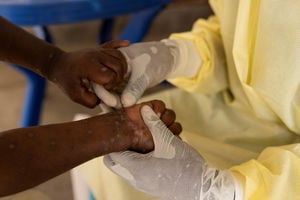What’s killing Kenyans the most?

In Kenya, antibiotic overuse is seen as one of the key drivers of antimicrobial resistance.
What you need to know:
- The illnesses include vaccine-preventable diseases such as measles and diphtheria, antimicrobial resistant infections, water and foodborne diseases such as cholera, hepatitis A and E as well as vector borne diseases such as malaria, dengue and chikungunya.
- Kenyans also need to watch out for cancer, tuberculosis, cardiovascular diseases, diabetes mellitus type 2, kidney, heart, and liver failure, anthrax, mental health disorders such as depression and alcoholism, trauma secondary to road traffic accidents and crime and air pollution related disorders such as chronic obstructive pulmonary disease.
Diseases that can be prevented are leading in the cause of deaths in Kenya, shining a spotlight on the need for nuanced public health education and investment in medical research.
Dr Paul Yonga, an infectologist and clinical epidemiologist in Nairobi, told Healthy Nation that Kenyans should watch out for 14 diseases in the coming year, based on findings of a recent survey.
Dr Yonga, who specialises in tropical medicine, transplant and immunocompromised host infectious diseases, noted that many of the things that kill Kenyans can be avoided.
“The illnesses include vaccine preventable diseases such as measles and diphtheria, antimicrobial resistant infections, water and foodborne diseases such as cholera, hepatitis A and E as well as vector borne diseases such as malaria, dengue and chikungunya,” he said. “Kenyans also need to watch out for cancer, tuberculosis, cardiovascular diseases, diabetes mellitus type 2, kidney, heart, and liver failure, anthrax, mental health disorders such as depression and alcoholism, trauma secondary to road traffic accidents and crime and air pollution related disorders such as chronic obstructive pulmonary disease.”
The Kenya Medical Research Institute (Kemri), which has developed an infectious and parasitic diseases research programme, says on its website that research is being conducted on vector control, bacterial, fungal and viral infections such as HIV/AIDS,TB, ebola, malaria, chikugunya, dengue fever and other Neglected Tropical Diseases(NTDs) like Kala azar and bilharzia.
“The programme is conducted with the aim of developing tools and technologies for the reduction of disease burden due to infectious and parasitic agents,” it reads.
In this regard, Kemri researchers warn that Kenyans should also watch out for HIV, noting that out of the 1.6 million people living with HIV virus in the country, 900,000 are on anti-retroviral – ARVs treatment. In 2022, the estimated HIV prevalence in Kenya was 3.7 per cent in adults aged 15–49, with 18,000 Kenyans dying from AIDS-related causes in the same year.
Although ARVs have reduced AIDS – related morbidity and mortality, they have resulted in HIV – 1 drug resistance and emergence of new strains whose virulence is yet to be established.
“The Center for Virus Research laboratory has identified new and evolving HIV genotypes in Kenya including the very rare subtype O, HIV -2 and a myriad of recombinants,” Kemri experts say.
Through research centers in Busia and Nairobi, Kemri has established the first ever HIV genotyping programme in the country.
Kenya, which had reported five cases of Mpox in September, should also watch out for the disease in 2025. Kenya was selected among five African countries set to receive 50,000 doses of the Mpox vaccine as part of an international effort to prevent the transmission of the disease.
Cancer, malaria and pneumonia continue to be some of Kenya’s biggest health challenges despite the scale-up of intervention tools, and that is expected to be the case in coming years.
Cancer is currently the biggest menace among the three diseases as it puts a huge financial and emotional burden on families, communities and the national health system.
The United Nations Population Fund places it at the top of the list of diseases killing Kenyans the most, with the Health ministry stating last year that in 2020, Kenya reported “42,000 new cancer cases and 27,000 cancer-related deaths. Notably, nine women die every day due to cervical cancer.”
Cervical and breast cancers contribute to 23 per cent of all cancer-related deaths in the country.
Every year, nearly 6.7 million clinical cases of malaria are reported in Kenya, with 70 per cent of the population being at risk, according to the Malaria Journal. It is estimated that approximately 4,000 people die from malaria annually, most of them being children.
According to the Ministry of Health, pneumonia is a leading cause of death for children under five in Kenya, killing between 8,000 and 10,000 children each year. This is about one in five child deaths in Kenya. Immunisations against the two most common bacteria that cause pneumonia have been shown to reduce the incidence of pneumonia by 22–35 per cent and child deaths by four per cent.
Early this month, Kemri announced the launch of a Phase 3 clinical trial for the M72/AS01E tuberculosis (TB) vaccine candidate in the country while highlighting that the study aims to assess the efficacy of the vaccine, which holds promise as a groundbreaking solution to combat pulmonary TB, the most common and deadly form of the disease, particularly in low and middle income countries.
Kenya is considered a high TB burden country by the World Health Organization, estimating that in 2021, 32,000 people in Kenya died from the disease.
“In Kenya, approximately 128,000 new TB cases are reported each year, underscoring the urgent need for new and effective vaccines, especially for adolescents and adults, where the current vaccine, BCG, offers limited protection,” Kemri highlights in an official statement.
It further discloses that following the first dosing of participants in South Africa in March 2024, Kenya has become the second country to join the trial in July 2024 with sites across nine locations nationwide.
If successful, M72/AS01E could be the first new TB vaccine in over a century, offering a new level of protection for adults and adolescents, and helping to significantly reduce TB transmission not just in Kenya, but worldwide.
Kemri is also involved in supporting efforts to combat the outbreak of Marburg Virus Disease (MVD) recently reported in Rwanda.




